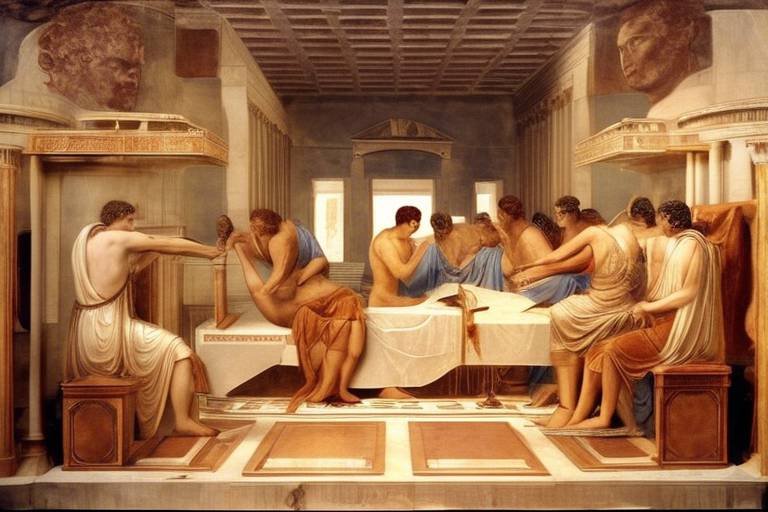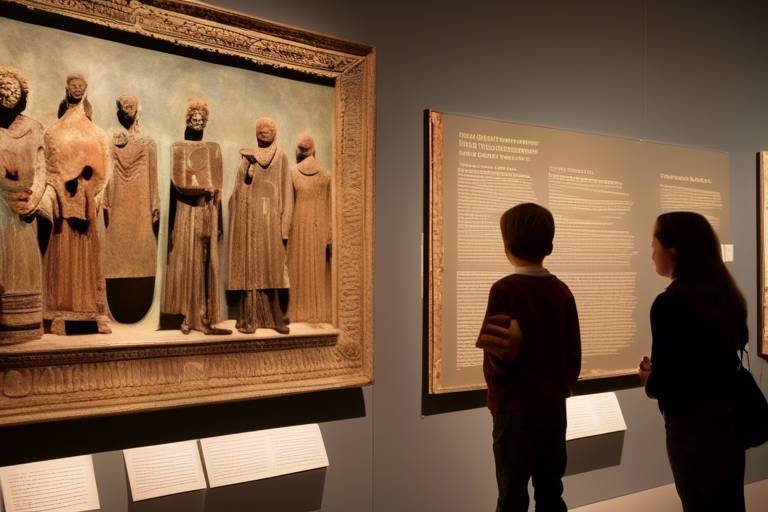The Role of Technology in Heritage Documentation
Technology plays a pivotal role in the documentation of heritage, revolutionizing the way we preserve and study historical sites, artifacts, and traditions. Advancements in technology have opened up a realm of possibilities, offering innovative tools and techniques that enhance our understanding and appreciation of cultural heritage.
One of the most groundbreaking technologies in heritage documentation is 3D scanning and modeling. By utilizing sophisticated 3D scanning technology, experts can create highly detailed and accurate digital replicas of heritage sites and artifacts. This method not only aids in preservation efforts but also provides researchers with invaluable insights into the past.
Digital archiving is another crucial aspect of heritage documentation. Through digital platforms and databases, vast amounts of cultural heritage data can be stored and managed efficiently. This enables easy access to valuable information, ensuring that our heritage is preserved for future generations.
Augmented Reality (AR) applications have also made significant contributions to heritage documentation. By integrating AR technology, visitors to heritage sites can enjoy interactive and immersive experiences, gaining a deeper understanding of history and culture in a captivating way.
Drone technology has transformed the way we survey and document heritage sites. Drones equipped with high-resolution cameras are used for aerial photography and mapping, allowing experts to capture detailed images of archaeological sites and landscapes from unique perspectives.
Virtual Reality (VR) tours have become increasingly popular in the heritage sector. Through VR technology, individuals can embark on virtual journeys to historical locations and explore artifacts with remarkable realism, transcending geographical boundaries.
Mobile apps tailored for heritage interpretation have made cultural heritage more accessible and engaging. These applications provide users with interactive guides and information about heritage sites, enriching their overall experience and fostering a deeper connection to our shared heritage.
Artificial Intelligence (AI) is playing a growing role in heritage analysis. AI algorithms are utilized to analyze and interpret vast amounts of heritage data, enabling researchers to uncover hidden patterns and insights that may have otherwise gone unnoticed, shedding new light on our collective past.
Geospatial technologies such as Geographic Information Systems (GIS) and Global Positioning System (GPS) are instrumental in heritage mapping. By harnessing these tools, experts can create detailed spatial representations of cultural landmarks, facilitating better documentation and preservation efforts.

3D Scanning and Modeling
3D scanning and modeling have revolutionized the field of heritage documentation by providing detailed and accurate digital replicas of historical sites and artifacts. Imagine being able to explore ancient ruins or delicate artifacts in intricate detail without even being physically present. This technology allows researchers and enthusiasts alike to study and preserve our cultural heritage in ways never before possible.
By using 3D scanning technology, experts can capture every minute detail of a heritage site or artifact, creating a virtual representation that can be analyzed and shared with a global audience. These digital replicas not only serve as valuable research tools but also help in the conservation and restoration of fragile objects and structures.
One of the key advantages of 3D scanning and modeling is the ability to create interactive experiences for visitors. Museums and heritage sites can offer virtual tours where visitors can explore these digital reconstructions, gaining insights into the history and significance of each object or location.
Furthermore, 3D scanning technology enables researchers to conduct virtual reconstructions of damaged or lost heritage sites, allowing us to piece together the past and understand how these sites may have looked centuries ago. It's like solving a historical puzzle, with each scan providing a new piece of the story.

Digital Archiving
Digital archiving plays a crucial role in the documentation and preservation of cultural heritage. In today's digital age, the importance of creating digital backups of historical documents, artifacts, and sites cannot be overstated. By digitizing these valuable assets, we ensure that they are safeguarded for future generations and accessible to a global audience.
One of the key benefits of digital archiving is the ability to store vast amounts of information in a compact and organized manner. Digital platforms and databases allow for the efficient management of cultural heritage data, enabling researchers, historians, and the general public to easily access and explore a wealth of information about our shared past.
Moreover, digital archiving facilitates the preservation of fragile and deteriorating materials. By creating high-quality digital replicas of ancient manuscripts, artworks, and archaeological sites, we can protect these treasures from physical degradation and environmental threats. These digital copies serve as invaluable resources for study, research, and educational purposes.
Through digital archiving, we are not only preserving the past but also shaping the future of heritage documentation. By harnessing the power of technology to digitize and archive cultural assets, we are ensuring that our rich history and traditions are not lost to time but are instead celebrated and shared with generations to come.

Augmented Reality (AR) Applications
Augmented Reality (AR) applications have revolutionized the way visitors experience heritage sites, bringing history to life in interactive and immersive ways. By superimposing digital information and visuals onto the real world, AR technology enhances the learning experience and provides a deeper understanding of cultural significance.
One of the key benefits of AR applications in heritage documentation is the ability to overlay historical images, videos, and information onto physical artifacts or ruins, allowing visitors to see how these sites looked in their original state. This hands-on approach engages users of all ages and backgrounds, making the exploration of heritage sites more captivating and educational.
Furthermore, AR technology enables users to interact with virtual elements in real-time, creating a dynamic and personalized experience. Visitors can access additional details, stories, and multimedia content simply by pointing their devices at specific points of interest, enriching their understanding of the site's historical context.
Moreover, AR applications can be used to reconstruct lost or damaged heritage structures virtually, offering a glimpse into the past that would otherwise be impossible. By merging the physical and digital worlds, AR technology bridges the gap between present-day visitors and the historical significance of heritage sites, fostering a deeper appreciation for cultural preservation.
In conclusion, Augmented Reality (AR) applications play a vital role in heritage documentation by transforming traditional site visits into interactive and educational experiences. By blending technology with history, AR enhances the way we engage with and learn about our cultural heritage, ensuring that future generations can continue to explore and appreciate the legacy of the past.

Drone Technology
Drone technology has revolutionized the field of heritage documentation by providing a bird's eye view of archaeological sites and landscapes. Drones equipped with high-resolution cameras and LiDAR sensors can capture detailed aerial imagery and create 3D models of heritage sites with unparalleled accuracy. These unmanned aerial vehicles offer a cost-effective and efficient way to survey and document large areas that are often inaccessible or difficult to reach on foot.
One of the key advantages of using drones in heritage documentation is their ability to capture data from multiple angles, allowing researchers to create comprehensive visual records of historical sites. By conducting aerial surveys, archaeologists can identify hidden features, track changes in landscapes over time, and monitor the condition of fragile structures without causing any disturbance to the site itself.
Moreover, drones play a crucial role in mapping and monitoring heritage sites at risk of natural disasters or human activities. By regularly collecting aerial data, conservationists can assess potential threats to cultural landmarks and implement preventive measures to safeguard these valuable assets for future generations.
In addition to their surveying and mapping capabilities, drones are also used in archaeological excavations to assist in locating and documenting artifacts buried beneath the surface. The data collected by drones can be integrated with GIS technology to create detailed maps and 3D models that provide valuable insights into the historical context and spatial relationships of archaeological finds.

Virtual Reality (VR) Tours
Virtual Reality (VR) Tours are revolutionizing the way we engage with heritage sites and artifacts, transporting users to historical locations without leaving their homes. Through the power of VR technology, individuals can immerse themselves in a virtual world where they can explore ancient ruins, museums, and cultural landmarks with unprecedented realism.
Imagine being able to walk through the corridors of the Egyptian pyramids or inspect intricate details of a Renaissance painting up close, all from the comfort of your living room. VR tours offer a unique and interactive way to experience history, allowing users to feel as though they are physically present in these significant locations.
These virtual experiences are not only educational but also entertaining, making learning about heritage sites an engaging and memorable experience. By putting on a VR headset, users can embark on virtual journeys that transcend time and space, bringing history to life in a way that traditional methods cannot replicate.
Moreover, VR tours open up opportunities for individuals who may not have the means to travel to these sites in person. Whether due to physical limitations or financial constraints, VR technology democratizes access to cultural heritage, enabling a wider audience to appreciate and learn from our shared past.

Mobile Apps for Heritage Interpretation
Mobile apps have revolutionized the way we interact with heritage sites, offering users a unique and interactive experience. These apps serve as virtual guides, providing visitors with historical information, interactive maps, and multimedia content to enhance their understanding of cultural landmarks.
Through mobile apps for heritage interpretation, users can access detailed information about artifacts, monuments, and historical events directly on their smartphones. These apps often include audio guides, 3D models, and augmented reality features that bring the past to life in a dynamic and engaging way.
One of the key benefits of using mobile apps for heritage interpretation is the ability to customize the visitor experience. Users can choose their preferred route, select specific points of interest, and delve deeper into the history and significance of each location at their own pace.
Furthermore, these apps facilitate accessibility for a wider audience, including individuals with disabilities or language barriers. By offering multilingual support, audio descriptions, and visual aids, mobile apps make cultural heritage more inclusive and engaging for all visitors.
In addition, some mobile apps for heritage interpretation incorporate gamification elements, turning exploration into a fun and educational experience. Users can participate in quizzes, scavenger hunts, and interactive challenges that encourage active learning and discovery.

Artificial Intelligence (AI) in Heritage Analysis
Artificial Intelligence (AI) plays a significant role in the analysis of heritage data, revolutionizing the way researchers interpret and understand cultural artifacts and sites. By harnessing the power of AI algorithms, heritage experts can delve deeper into historical information and uncover hidden insights that may have remained undiscovered through traditional methods. Machine learning algorithms are trained to recognize patterns and trends within vast amounts of heritage data, enabling researchers to make connections and draw conclusions that contribute to a richer understanding of our past.
One of the key advantages of utilizing AI in heritage analysis is its ability to process and analyze data at a speed and scale that surpasses human capabilities. By automating tasks such as data classification, pattern recognition, and anomaly detection, AI streamlines the analysis process, allowing researchers to focus their efforts on higher-level interpretation and exploration. This not only saves time but also enhances the accuracy and depth of insights derived from heritage data.
Moreover, AI algorithms can assist in the preservation and restoration of cultural heritage by predicting potential risks, identifying areas of deterioration, and recommending appropriate conservation strategies. By analyzing historical trends and environmental factors, AI can help heritage professionals make informed decisions to ensure the longevity and integrity of precious artifacts and sites for future generations.

Geospatial Technologies for Heritage Mapping
Geospatial technologies play a vital role in the mapping and documentation of heritage sites, offering a sophisticated way to create detailed spatial representations of cultural landmarks. By combining Geographic Information Systems (GIS) and Global Positioning System (GPS) technologies, researchers and archaeologists can accurately map and analyze heritage sites with precision and efficiency.
GIS allows for the collection, storage, analysis, and visualization of spatial data, enabling experts to create layered maps that display various aspects of a heritage site, such as topography, vegetation, and structures. This comprehensive approach provides a holistic view of the site, aiding in the preservation and management of cultural heritage.
Moreover, GPS technology plays a crucial role in georeferencing archaeological finds and accurately mapping the layout of heritage sites. By utilizing GPS receivers, researchers can pinpoint the exact location of artifacts and structures within a site, creating detailed maps that help in understanding the historical context and spatial relationships of different elements.
Furthermore, geospatial technologies facilitate the monitoring and conservation of heritage sites by tracking changes in the landscape over time. Through satellite imagery and aerial surveys, researchers can identify potential threats to cultural heritage, such as natural disasters or human encroachment, and implement strategies to protect and preserve these invaluable assets.
In essence, the integration of GIS, GPS, and other geospatial technologies in heritage mapping not only enhances our understanding of the past but also contributes to the sustainable management and safeguarding of cultural heritage for future generations.
Frequently Asked Questions
- What is heritage documentation?
Heritage documentation involves the process of recording, preserving, and presenting cultural heritage including sites, artifacts, and traditions using various technological tools and techniques.
- How does 3D scanning benefit heritage preservation?
3D scanning enables the creation of highly detailed digital replicas of heritage sites and artifacts, allowing for better study, conservation, and virtual exploration of historical objects and structures.
- Why is digital archiving important in heritage preservation?
Digital archiving plays a crucial role in storing and managing vast amounts of cultural heritage data efficiently, ensuring long-term preservation and accessibility for future generations.
- What are some examples of AR applications in heritage sites?
AR applications enhance the visitor experience by providing interactive and immersive ways to learn about history and culture, offering virtual tours, information overlays, and interactive storytelling at heritage sites.
- How do drones contribute to heritage documentation?
Drones are used for aerial photography and mapping to survey and document large archaeological sites and landscapes, providing detailed visual data that aids in research, conservation, and monitoring of heritage sites.
- What can users expect from VR tours of heritage sites?
VR tours allow users to virtually explore historical locations and artifacts from anywhere in the world, offering an immersive and educational experience that brings heritage sites to life in a realistic and engaging manner.
- How do mobile apps enhance heritage interpretation?
Mobile apps provide users with interactive guides and information about heritage sites, offering engaging ways to learn about cultural heritage through multimedia content, augmented reality features, and location-based services.
- What role does AI play in heritage analysis?
AI algorithms are used to analyze and interpret heritage data, assisting researchers in uncovering new insights, patterns, and connections within cultural heritage materials, contributing to a deeper understanding of our past.
- How are geospatial technologies utilized in heritage mapping?
Geospatial technologies like GIS and GPS are employed to map and document heritage sites with detailed spatial representations, enabling accurate spatial analysis, monitoring of changes, and preservation planning for cultural landmarks.



















